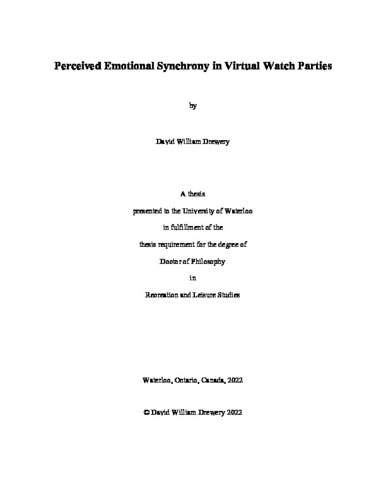| dc.description.abstract | The appeal of many leisure activities emerges from “shared experience,” wherein participants feel an emotional synchrony with fellow participants. Essentially, participants’ emotions are enhanced by their awareness of and agreement with others’ emotional state. The physical presence of others has always been considered a necessary condition for such synchrony. Yet, recent anecdotal evidence suggests this may not be the case. Specifically, virtual settings (e.g., online gaming, live-streaming concerts) in which others’ physical presence is absent may also have the capacity to generate perceived emotional synchrony. Drawing primarily from shared attention theory, this dissertation explores conditions for perceived emotional synchrony in the context of virtual watch parties. It focuses on how such synchrony relates to positive emotional responses to the experience.
Findings from a survey of participants’ experiences within virtual watch parties suggest that such experiences represent opportunities to connect with others, especially during the ongoing COVID-19 pandemic. Findings from an experiment involving those same participants suggest that, as expected, perceived emotional synchrony was positively associated with positive emotional responses: positive emotional state, overall enjoyment, and willingness to share the video with friends. Emotional synchrony rendered the experience more worthwhile. This relationship held while controlling for trait-like tendency to experience emotional synchrony and self-reported shared attention.
Importantly, we were able to create this synchrony among participants who were physically alone as they watched an online event. Results suggest that shared attention, the perception that “we” are attending together, encourages perceived emotional synchrony in virtual experiences. Mentalization, thinking about co-attendees’ experiences, helped to explain the relationship between shared attention and perceived emotional synchrony. Findings from the experiment further suggest that the social context of shared attention further influenced perceived emotional synchrony. Perceived emotional synchrony was highest when backchannel communication, the exchange of text-based messages with other participants during the experience, was present. This was the case regardless of the level of shared identity between participants.
These findings offer new insights regarding conditions for creating shared experiences. They demonstrate that others’ physical presence is not necessary for perceptions of emotional synchrony. Rather, a sense that others who are located elsewhere are co-attending to a shared event can contribute to such synchrony. Sharing attention encourages participants to think about others’ experiences and compare those to their own emotional states, resulting in a sense of connection. Further, these findings demonstrate the importance of backchannel communication in the creation of shared experiences. Whether participants identified with co-viewers, text-based exchanges provided a window to others’ emotions, adding to perceived emotional synchrony.
Ultimately, the dynamics of emotional connection resulted in more positive emotional responses to a shared event. This insight has profound implications for leisure providers. Physical proximity is less critical if providers offer tools that enable the exchange of emotional information. In doing so they can render virtual spaces capable of supporting shared experiences. Such experiences have important implications for the development interpersonal relationships, individual and community well-being, and client repatronage outcomes. This exploration of perceived emotional synchrony is essential to our evolving understanding of leisure service delivery. | en |

